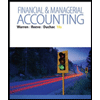
1.
Bonds: Bonds are long-term promissory notes that are represented by a company while borrowing money from investors to raise fund for financing the operations.
Bonds Payable: Bonds payable are referred to long-term debts of the business, issued to various lenders known as bondholders, generally in multiples of $1,000 per bond, to raise fund for financing the operations.
Discount on bonds payable: It occurs when the bonds are issued at a low price than the face value.
Effective-interest amortization method: Effective-interest amortization method it is an amortization model that apportions the amount of bond discount or premium based on the market interest rate.
To prepare:
2(a)
To prepare: Journal entry to record first interest payment and amortization of bond discount on December 31, 2016.
2 (b)
To prepare: Journal entry to record second interest payment and amortization of bond discount on June 30, 2017
3.
The amount of total interest expense for 2016.
Want to see the full answer?
Check out a sample textbook solution
Chapter 14 Solutions
Custom Bundle: Accounting, Loose-leaf Version, 26th + Working Papers, Chapters 1-17, 26th Edition
- Solve thisarrow_forwardMartinez Industries manufactures wood polish. The standard direct materials quantity is 0.70 pounds per bottle at a cost of $2.80 per pound. The actual usage for the production of 45,000 bottles was 0.75 pounds per bottle at an actual cost of $2.75 per pound. Calculate the direct materials price variance and the direct materials quantity variance.arrow_forwardGeneral accounting questionarrow_forward
- The standard labor cost in the production of a pair of Thunder Brand running shoes is 0.60 hours at $18 per hour. During the month of July, 32,000 pairs were produced. Actual labor costs were $182,000 for 10,250 hours. Compute the labor rate variance and labor efficiency variance for the month of July.arrow_forwardProvide Answerarrow_forwardI am looking for the correct answer to this general accounting question with appropriate explanations.arrow_forward
- Question 9 of 12 View Policies Current Attempt in Progress Crane Manufacturing Company uses a job order cost system and keeps perpetual inventory records. June 1 Purchased raw materials for $16,400 on account. 8 Raw materials requisitioned by production: $6,560 Direct materials Indirect materials 820 Paid factory utilities, $1,722 and repairs for factory equipment, $6,560. 15 25 Incurred $108,000 of factory labor. 25 Time tickets indicated the following: Direct Labor (7,000 hrs x $12 per hr) $84,000 Indirect Labor (3,000 hrs x $8 per hr) 24,000 $108,000 - / 12.5 III 25 28 80 00 Applied manufacturing overhead to production based on a predetermined overhead rate of $7 per direct labor hour worked. Goods costing $18,200 were completed in the factory and were transferred to finished goods inventory. 30 Goods costing $15,200 were sold for $20,200 on account.arrow_forwardCould you explain the steps for solving this financial accounting question accurately?arrow_forwardI am trying to find the accurate solution to this general accounting problem with the correct explanation.arrow_forward
 Financial AccountingAccountingISBN:9781305088436Author:Carl Warren, Jim Reeve, Jonathan DuchacPublisher:Cengage LearningPrinciples of Accounting Volume 1AccountingISBN:9781947172685Author:OpenStaxPublisher:OpenStax College
Financial AccountingAccountingISBN:9781305088436Author:Carl Warren, Jim Reeve, Jonathan DuchacPublisher:Cengage LearningPrinciples of Accounting Volume 1AccountingISBN:9781947172685Author:OpenStaxPublisher:OpenStax College Excel Applications for Accounting PrinciplesAccountingISBN:9781111581565Author:Gaylord N. SmithPublisher:Cengage Learning
Excel Applications for Accounting PrinciplesAccountingISBN:9781111581565Author:Gaylord N. SmithPublisher:Cengage Learning Financial & Managerial AccountingAccountingISBN:9781285866307Author:Carl Warren, James M. Reeve, Jonathan DuchacPublisher:Cengage Learning
Financial & Managerial AccountingAccountingISBN:9781285866307Author:Carl Warren, James M. Reeve, Jonathan DuchacPublisher:Cengage Learning Financial Accounting: The Impact on Decision Make...AccountingISBN:9781305654174Author:Gary A. Porter, Curtis L. NortonPublisher:Cengage Learning
Financial Accounting: The Impact on Decision Make...AccountingISBN:9781305654174Author:Gary A. Porter, Curtis L. NortonPublisher:Cengage Learning College Accounting, Chapters 1-27AccountingISBN:9781337794756Author:HEINTZ, James A.Publisher:Cengage Learning,
College Accounting, Chapters 1-27AccountingISBN:9781337794756Author:HEINTZ, James A.Publisher:Cengage Learning,





